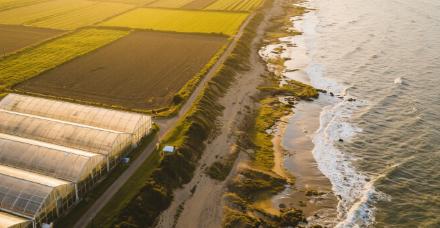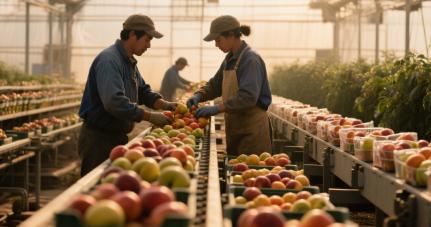Opportunities and Challenges in Modern Agriculture
As global temperatures rise and arable land shrinks, climate-controlled greenhouses are emerging as one of the most promising solutions in modern agriculture. They combine smart technology with controlled environments to deliver high yields, reduce crop losses, and enable year-round production.
But behind the glossy exterior of innovation lie some real-world challenges. Is this model suitable for every region, crop, and farmer? What are the practical opportunities—and potential pitfalls—of climate-controlled greenhouse farming?
Let’s explore both sides of the coin.
What Makes Climate-Controlled Greenhouses So Appealing?
The core appeal of a climate-controlled greenhouse lies in its ability to detach farming from natural weather patterns. With the right setup, you can grow strawberries in winter, tomatoes in desert climates, or herbs in city centers.
Here’s why many growers are taking notice:
Stable Yield: Climate systems regulate temperature, humidity, and light, protecting crops from frost, droughts, and heatwaves.
Efficient Water Use: Compared to open-field farming, greenhouses use up to 70% less water thanks to precision drip irrigation and recycling systems.
Fewer Chemicals: Pest and disease pressures drop when air and soil conditions are controlled, reducing the need for heavy pesticide use.
Urban and Vertical Integration: Climate-controlled setups are ideal for urban farming and vertical models, shortening the farm-to-table cycle.
High-Value Crops: From blueberries to hydroponic lettuce, these systems enable consistent quality and premium pricing.
With rising interest in sustainable, tech-driven farming, many companies—including Chengfei Greenhouse—are helping clients integrate automation, smart controls, and efficient designs into their operations.
What Technologies Power These Greenhouses?
Today’s greenhouses go far beyond plastic tunnels. A modern facility can include:
Heating/Cooling Systems: Heat pumps, fans, and cooling pads maintain optimal growth temperatures.
Smart Lighting: LED grow lights simulate sunlight during cloudy days or nighttime.
Humidity & CO₂ Control: Maintaining balance prevents mold and maximizes photosynthesis.
Automated Sensors: These monitor soil moisture, air quality, and light levels, adjusting systems in real time.
Fertigation Units: Precision delivery of water and nutrients based on crop needs.
In tech-friendly regions, entire farms are now monitored remotely via smartphone apps and cloud-based dashboards, making 24/7 control a reality.


What Crops Are Best for Climate-Controlled Environments?
Not all crops are worth growing in a high-tech environment. Since climate-controlled greenhouses require higher upfront investment, they’re best matched with crops that offer premium returns:
Strawberries and Blueberries: Benefit from a stable microclimate and fetch high prices.
Tomatoes and Bell Peppers: Fast turnover, high market demand.
Leafy Greens and Herbs: Short cycles, ideal for hydroponic systems.
Orchids and Edible Flowers: High-value niche markets.
Medical or Specialty Crops: Controlled conditions are essential for consistency and compliance.
Regions like South Africa, the UAE, and Southeast Asia have seen growing success with greenhouse-grown tomatoes and peppers, particularly where outdoor farming is limited by harsh climates.
What Are the Main Challenges?
While climate-controlled greenhouses offer clear benefits, they also come with a unique set of challenges:
1. High Capital Investment
Initial setup costs for even a small greenhouse with proper automation can reach hundreds of thousands of dollars. This can be a major barrier for smallholders or startups without funding support.
2. Energy Dependency
Maintaining climate control, especially in extreme weather, requires significant energy input. Without access to renewable energy or efficient insulation, operational costs can spike.
3. Technical Knowledge Required
Automated systems and high-density planting require trained staff. Poor management can lead to underperformance or system failure.
4. Market Access and Price Pressure
Growing premium crops is only profitable if you have reliable sales channels. If supply outpaces demand, prices drop—and so do profits.
5. Maintenance and Repairs
Tech-heavy systems need regular maintenance. Sensor failures or irrigation clogs can cause major crop loss if not resolved quickly.
How Can Farmers and Investors Overcome These Obstacles?
Succeeding with climate-controlled greenhouses requires more than money. It takes planning, partnership, and education.
Start Small, Then Scale: Begin with a manageable pilot and expand based on results.
Partner with Experts: Companies like Chengfei Greenhouse provide design, tech integration, and after-sales service that greatly reduce early-stage risk.
Train the Team: Skilled labor is a major asset. Invest in training programs for staff and farm managers.
Secure Sales Before You Grow: Build agreements with supermarkets, restaurants, or e-commerce platforms before your first harvest.
Leverage Government Subsidies: Many countries now offer agricultural innovation funds or energy efficiency grants—take advantage of them.
What Does the Future Hold?
Looking ahead, climate-controlled greenhouses will likely become more common—not just for their productivity but for their alignment with sustainable goals.
Emerging trends include:
Solar-Powered Systems: Cutting operational energy costs
AI-Powered Growth Models: Using data to predict and enhance crop cycles
Carbon-Neutral Certifications: Meeting rising consumer demand for low-footprint produce
Compact Modular Designs: Making high-tech greenhouses accessible in urban spaces
From rooftop farms in Singapore to desert operations in the Middle East, the greenhouse revolution is global—and it’s only just beginning.
Climate-controlled greenhouses are not a silver bullet, but they are a powerful tool. For those who invest wisely and manage effectively, the rewards—both financial and ecological—can be immense.
Post time: Jul-17-2025







 Click to Chat
Click to Chat